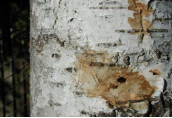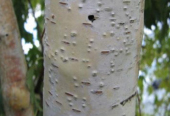HOST PLANTS:
Bronze birch borer is host to birch trees, usually white barked birches. River birch is more resistant.![]()
DAMAGE:
This beetle attacks injured and weakened trees. Spiral ridges around branches and the trunk indicate the feeding tunnels of the larvae. Symptoms include sparse growth, chlorotic leaves or die back in the upper crown as larval feeding causes girdling in the trunk disrupting the flow of water and nutrients in the tree. D shaped exit holes on the trunk are positive identification for this pest. Brownish weeping on the trunk from 1st larval instar activity is usually noticed in August.
DESCRIPTION AND LIFE CYCLE:
Insects overwinter as larvae in galleries in the vascular system and resume feeding in spring as the sap rises. Adults emerge over a period of about 6 weeks, from June to August when pagoda dogwood and hawthorns are in full bloom, through a D-shaped hole. Females lay eggs on the bark and larvae hatch out and begin boring into the bark around the time that European cranberry-bush viburnum or weigela are in bloom. Larvae may take up to two years to complete their development. Larvae are 1/2 to 1 inch long, light colored, with a flat head that is slightly wider than the body. Adults are slender beetles that are a metallic green-brown color and are 6-12mm in length. Adults feed on the foliage of birch, alder and poplar but damage in insignificant.
CONTROL MEASURES:
- Maintain good tree health through regular fertilization, proper irrigation, mulching and judicious pruning.
- Plant resistant species and avoid planting in hot, dry sites.
- Remove badly infected trees to reduce breeding areas. Prune out dead in the fall so that females are not attracted to the open cuts as a site for egg laying.
- Apply approved insecticides to target the young larvae before they tunnel into the bark. Chemical control is very difficult.




Reference: Publication 383, IPM Scouting Guide for Woody Landscape Plants by Diane Brown-Rytlewski
